 |
 |
 |
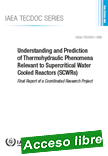 |
Understanding and Prediction of Thermohydraulic Phenomena Relevant to Supercritical Water Cooled Reactors (SCWRs)
Final Report of a Coordinated Research Project IAEA TECDOC No. 1900 English IAEA-TECDOC-1900 978-92-0-102320-9 544 386 2020
This publication is the outcome of an IAEA coordinated research project (CRP) on understanding and prediction of thermohydraulic phenomena relevant to supercritical water cooled reactors (SCWRs). The publication illustrates the state of the art in SCWR research and development.
|
It is a key supporting publication to researchers and engineers pursuing the development of SCWRs or equipment/components operating at supercritical pressures. Scientific investigators from participating institutes identified specific research objectives to improve predictive capability of key technology areas (such as heat transfer and pressure drop for SCWR fuel related geometries, parallel channel stability boundary, natural circulation flow, critical heat flux at near critical pressures, critical flow, and subchannel and plenum mixing). The publication presents the background and objectives and descriptions of the revised Canadian SCWR design concept and a new SCWR design concept being developed at the Nuclear Power Institute of China. It also presents updated information on key areas of technology, such as supercritical heat transfer in simple geometries, stability and critical flow, which have been obtained after the completion of the previous CRP. New experiments and data on supercritical heat transfer in bundles and on critical heat flux, and the application of direct numerical simulation approach for supercritical heat transfer are also detailed.
|
 |
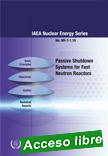 |
Passive Shutdown Systems for Fast Neutron Reactors
IAEA Nuclear Energy Series NP-T-1.16 - English STI/PUB/1863 978-92-0-104219-4 2020
Designs for nuclear power plants increasingly include passive features. A major focus of the design of modern fast reactors is on inherent and passive safety. Inherent and passive safety features are especially important when active systems such as emergency shutdown systems for reactor shutdown are not functioning properly. This publication discusses the past experience in the development of such systems along with the research that is ongoing.
|
It is a comprehensive publication which provides information on the basic design principles for passive shutdown systems and the related operational experience gathered so far, and also reviews the innovative concepts under development and the needs for research and development and qualification tests.
|
 |
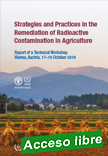 |
Strategies and Practices in the Remediation of Radioactive Contamination in Agriculture - Report of a Technical Workshop Held in Vienna, Austria, 17–18 October 2016
English STI/PUB/1904 978-92-0-102120-5 - 194 31 50.00 2020)
This publication presents the proceedings of a workshop on the remediation of radioactive contamination in agriculture. The workshop brought together specialists from different countries and technical backgrounds and sought to disseminate research findings and encourage future studies aimed at the development of technologies to support sustainable agricultural production and rural development after a nuclear accident.
|
The presentations and discussions at the meeting focused on both laboratory findings and practical field-work experience in planning and implementing remediation activities. The participants provided information related to agricultural production in Japan after the Fukushima Daiichi accident and in the many different countries affected by the Chernobyl accident. The workshop contributed to the dissemination of information and knowledge in this very distinct area and produced conclusions, recommendations and observations to enhance preparedness and response planning for nuclear emergencies and radiological incidents in relation to food and agriculture. This publication is targeted at authorities responsible for food and agriculture, international organizations working in this area, as well as professionals and academics involved in the remediation of radioactive contamination. It will also be of interest to nuclear safety or emergency planning and response specialist.
|
 |
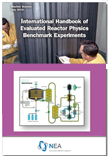 |
International Handbook of Evaluated Reactor Physics Benchmark Experiments
2019
English, published: 12/02/19
NEA#7496
The International Handbook of Evaluated Reactor Physics Benchmark Experiments contains reactor physics benchmark specifications that have been derived from experiments that were performed at nuclear facilities around the world. The benchmark specifications are intended for use by reactor designers, safety analysts and nuclear data evaluators to validate calculation techniques and data.
|
While co-ordination and administration of the International Reactor Physics Evaluation (IRPhE) project is undertaken by the Nuclear Energy Agency (NEA) at the international level, each participating country is responsible for the administration, technical direction and priorities of the project within their respective countries. The information and data included in this handbook are available to NEA member countries, to all contributing countries and to others on a case-by-case basis. Example calculations are presented; however, these do not constitute validation or endorsement of the codes or cross-section data.
The 2019 edition of the International Handbook of Evaluated Reactor Physics Benchmark Experiments contains data from 166 experimental series that were performed at 56 nuclear facilities. A total of 162 of the 166 evaluations are published as approved benchmarks. The remaining four evaluations are published as draft documents only.
The cover of the handbook shows the graphite structural material from the Molten-Salt Reactor Experiment (MSRE) performed at Oak Ridge National Laboratory (ORNL), United States. Newly evaluated measurements from MSRE have been added to this edition of the handbook.
The 2019 edition is available online at: https://doi.org/10.1787/8d549c0f-en.
|
 |
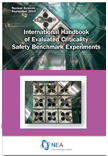 |
International Handbook of Evaluated Criticality Safety Benchmark Experiments
2019 English, published: 09/06/19
NEA#7497
The Criticality Safety Benchmark Evaluation Project (CSBEP) was initiated in 1992 by the United States Department of Energy. The project quickly became an international effort as scientists from other interested countries became involved. The International Criticality Safety Benchmark Evaluation Project (ICSBEP) became an official activity of the Nuclear Energy Agency (NEA) in 1995. This handbook contains criticality safety benchmark specifications that have been derived from experiments performed at critical facilities around the world.
|
The benchmark specifications are intended for use by criticality safety engineers to validate calculation techniques used to establish minimum subcritical margins for operations with fissile material and to determine criticality alarm requirements and placement. Many of the specifications are also useful for nuclear data testing. Example calculations are presented; however, these do not constitute a validation of the codes or cross-section data.The evaluated criticality safety benchmark data in the 2019 edition are presented in nine volumes. These volumes span over 70 000 pages and contain 574 evaluations with benchmark specifications for 4 973 critical, near-critical or subcritical configurations, 45 criticality alarm placement/shielding configurations with multiple dose points for each, and 237 configurations which have been categorised as fundamental physics measurements that are relevant to criticality safety applications.New to the handbook are subcritical experiments with the Inherently Safe Subcritical Assembly (ISSA), carried out in the ISSA laboratory at Lawrence Livermore National Laboratory (LLNL) in the United States. A photograph of the core tank exterior is shown on the handbook cover.The 2019 edition is available online at: https://doi.org/10.1787/110ba6fc-en.
|
 |
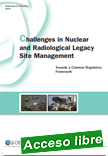 |
Challenges in Nuclear and Radiological Legacy Management
English, published: 12/16/19
NEA#7419
Many countries are dealing with challenges stemming from nuclear and radiological legacy sites. In particular, managing these sites in an open and transparent fashion while taking into account the views of all relevant stakeholders and building confidence in the solutions adopted is an ongoing challenge.
This report provides information on the challenges and lessons learnt in legacy management and regulation based on practical experience documented in 13 case studies and site visits conducted by the OECD Nuclear Energy Agency.
|
A preliminary framework for a stepwise process to help reach an accepted and sustainable end-state is proposed based on this experience. The complex challenges and interactions among stakeholders in progressing in a harmonised, step-by-step manner are also examined in depth. The report concludes with recommendations for future international collaborative work to improve and test the preliminary framework, and to examine and address the complexity of the relevant interactions.
|
 |
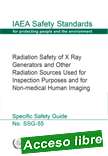 |
Radiation Safety of X Ray Generators and Other Radiation Sources Used for Inspection Purposes and for Non-medical Human Imaging
IAEA Safety Standards Series No. SSG-55
This Safety Guide provides recommendations on specific safety measures to meet the requirements of IAEA Safety Standards Series No. GSR Part 3 and other relevant Safety Requirements publications on the use of X ray generators and other types of radiation sources that are used for inspection purposes and for non-medical human imaging.
|
The recommendations provided are primarily for organizations that are authorized to use X ray generators and other types of radiation sources for such purposes, as well as for radiation protection experts, radiation protection officers and staff of regulatory bodies. The publication may also be of interest to designers and manufacturers of relevant X ray generators and sources.
|
 |
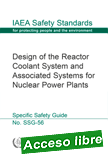 |
Design of the Reactor Coolant System and Associated Systems for Nuclear Power Plants
IAEA Safety Standards Series No. SSG-56
This Safety Guide provides recommendations on how to meet the requirements established in IAEA Safety Standards Series No. SSR-2/1(Rev. 1) in relation to the reactor coolant system and associated systems for nuclear power plants. It is a revision of IAEA Safety Standards Series No. NS-G-1.9 which it supersedes. The publication takes into account developments, experience and practices in the design of nuclear power plants throughout their lifetime.
|
It references and considers other IAEA safety standards that are relevant and related to the design of the reactor coolant system and associated systems for nuclear power plants. Recommendations to achieve the required reliability of the capabilities designed to transfer residual heat to the ultimate heat sink in the different plant states are also included. As those systems are dependent on specific reactor technologies, more appropriate recommendations have been developed for pressurized light water reactors, boiling water reactors and pressurized heavy water reactors respectively.
|
 |
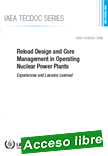 |
Reload Design and Core Management in Operating Nuclear Power Plants
Experiences and Lessons Learned
This publication represents a general consensus among participating experts of the best common practices that can be used at nuclear power plants (NPPs) in reload design and core management. It outlines the main issues to be considered when developing and improving reload design and core management and presents lessons learned, as well as detailing challenges which may be encountered.
|
Guidance provided here also covers best practice for different reload strategies and how to optimize reactor reload design and core management during the lifetime of a NPP. The publication reflects the advice of experts with experience of reactors of various types on how the operating organization may achieve its goals.
|
 |
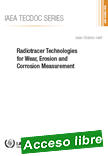 |
Radiotracer Technologies for Wear, Erosion and Corrosion
Measurement
This publication presents the performance and possibilities of radiotracer methodologies and technologies applied for monitoring and measuring the wear and corrosion, with focus on the thin layer activation (TLA) method. Different aspects of the method are discussed, and typical case studies are presented. Wear and corrosion substantially limit the endurance and reliability performance of nearly all machines, industrial equipment, transportation systems, power plants and their components.
|
Consequently, the development of effective methods of detection, measurement and monitoring of such processes is of great importance. Appropriate methods of monitoring can prevent accidents and also economic losses due to unforeseen breakdown of machinery. When the surfaces are not accessible or are concealed by overlaying structures, nuclear methods such as charged particle and neutron activations, become the most powerful tool for measurement and monitoring of wear and corrosion. Gamma-radiation passes through the materials and even low activities can be detected with high sensitivity and precision. In the case of TLA, only the surface layers in the micrometre range (the part subject to wear or corrosion) are activated.The information provided in this publication will be a useful source for radiation and radioisotope technologists in promoting these technologies to end users.
|
 |
| |
|
|

|
|
|
| |
|
|
| |
| |
|
|
| |
| |
|
|
| |
| |
|
|
|
| |
| |
